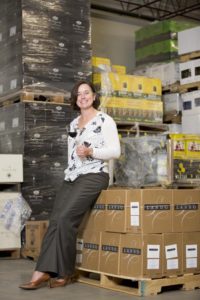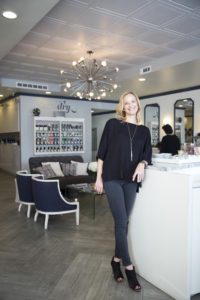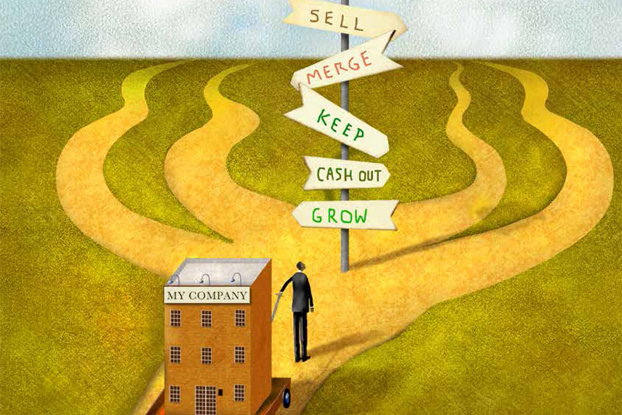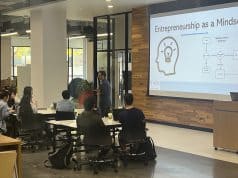
Twice in the past 18 months, Jeffrey L. Chernick 04BBA, CEO and cofounder of Los Angeles-based RideAmigos, has received the call that entrepreneurs dream about: an outside company was interested in buying his business.
Founded in 2007, RideAmigos began as an online ridesharing resource for commuters. It evolved into a comprehensive trip-planning service embracing all the different ways of getting to and from work or school, including walking, biking, public transit, carpooling, and driving. “Companies and organizations contract RideAmigos’ software in an effort to reduce traffic congestion at their facilities or to mitigate their lack of parking space,” Chernick explains. “They may work with us as part of a larger initiative to promote environmental sustainability by having fewer single-occupancy vehicles on the roads.”
The first offer Chernick entertained for the company went pretty far into the negotiation process. “It involved three months of due diligence,” he says. “We presented our story, showed our financials, and we had conversations about what our combined technologies would look like in the future. It was quite exciting.” But, when it came time for rubber to meet the road, the acquisition offer was lower than originally presented. “That was really disappointing, so we said no.”
Cover Story Sidebars
Featured Alumni
Shortly thereafter, a second company expressed interest in acquiring RideAmigos, but after a series of discussions, both parties agreed to not move forward.
At present, Chernick is engaged in preliminary merger and acquisition talks with yet another potential buyer. “Timing is everything,” he says. “You want to sell from a place of power, not a place of fear.”
At some point, many entrepreneurs or small-business owners face a choice to either stay the course or sell their business, in whole or in part. In this feature, alumni and faculty share their insights on the decision-making process and the many factors that influence it from a seller’s point of view.
Charlie Goetz, senior lecturer in organization & management and a serial entrepreneur himself, will tell you the choice is not often easy or straightforward, which explains why he’s contacted 10 to 20 times a week by alumni and students seeking guidance in this area. “Each business is different, so when I counsel them, I ask what their goals are—merge, cash out, or grow the business. Making that determination is the first step in the decision-making process.”
The making of a merger

For Lisa Allen 01MBA, meeting customer demand brought the choice to keep or sell her firm front and center.
In 2005, Allen launched Big Boat Wine Co., a fine-wine distributor offering about 350 brands to retail stores and restaurants in the 10-county metro Atlanta area. For the next eight years the business grew at a healthy double-digit annual rate. Its success attracted a stream of potential buyers, both inside and outside the alcohol industry, sparking casual “what if” conversations between Allen and her family-member stakeholders. Since the company was doing so well, a scenario for change didn’t come to mind.
Eventually, large customers like Costco and Whole Foods began expressing a desire to carry Big Boat’s wines at their Georgia locations outside metro Atlanta. “Getting to that point would have required many more trucks, salespeople, and warehouse space,” she says. “Everything was going to have to change.”
For the company to reach the next level on its own, it would have to incur a substantial amount of debt. Allen, who prided herself on Big Boat’s lack of debt, didn’t like that idea.
She opted to sell to a competitor, but with conditions that more resembled a merger.
Besides making sure Big Boat was valued fairly and the sale price reflected her role in growing it, she wanted to ensure the match was a good fit. “I wanted to do right by my brands and their people and make sure they could continue to be successful in the market,” she says. “I didn’t want my company to be an isolated subset of some other company.” She also wanted Big Boat’s eleven employees—including herself—to have the opportunity to continue working there.
She retained the services of a business broker with a background in the alcohol industry, which led her to the oldest distributor in Georgia.
Savannah Distributing Co., a private, family-owned wholesaler since 1938, was interested in expanding its reach in the wine business. Allen’s CPA and Savannah’s CFO sat down and shared their books. The fact that Big Boat was debt free made it easy to assess on paper.
“The negotiations were very easy and enjoyable, not stressful or antagonistic,” Allen says. “We both knew we had something to gain from the opportunity, and that helped us to get across the finish line.”
The deal was finalized in November 2013, and Allen found herself back in familiar territory as director of fine wines at Savannah Distributing’s Atlanta office.
“It was nice to know that I would still have a place in the industry,” she says. “Being part of something that’s bigger than myself has really been fun.”
According to Goetz, deals like Allen’s are not uncommon. “It’s not unusual for the buyer of a private firm to insist the former owner remain with the company. The terms could be as short as one year to as many as five,” he says. “The reason is simple: you have all the connections and expertise.”
Transitioning from family firm to internationally owned

Shifting gears and positions is the scenario James Barnard 06MBA, former vice president and co-owner of Chicago-based Anderson Pest Solutions, is enjoying. As part of the sale of his family firm to the global pest control leader Rentokil, Barnard is leading the integration of Anderson and Rentokil in the Midwest.
When Barnard was recruited in 2008 by his uncle Mark O’Hara, his plan was to run the business and eventually pass the reins to another family member. After all, the company had been a family business since Barnard’s grandfather founded it in the late ’40s.
Over the years, Anderson’s growth secured its spot as the largest family-owned pest control company in the Midwest, with 200 employees and 20,000 customers. With annual sales of about $22 million, it was also 30th largest in the US. As O’Hara began transitioning into retirement, with no other family members expressing an interest in the company, Barnard recognized that sooner or later, he would have a succession issue.
Since Anderson was doing well—growing at 5 percent a year versus the industry norm of 2 to 3 percent—Barnard and his uncle agreed it was an opportune time to sell, if the right buyer could be found. As the leader in the major Chicago-area market, they’d be negotiating from a position of power. They enlisted a broker agent to narrow the list of potential buyers and manage certain aspects of the negotiations.
“At the time you’re selling, you may have an extreme emotional attachment to your company,” says Erika Hall, assistant professor of organization & management and an expert in negotiation strategy. “Broker agents allow you the flexibility to have emotional detachment when negotiating, which sometimes allows for a better deal.”
Barnard concedes the point. “There were days when my uncle and I were like, ‘I don’t want to sell the company.’ There were other days when we were saying, ‘It’s really exhausting to run the company, and at some point we know we’re going to have to sell.’” After examining several offers, Barnard and his uncle settled on negotiating with the UK’s Rentokil, not because it had the highest bid—it didn’t—but because they felt it would be the best fit for their employees. Rentokil is a public company based in London, England. It lacked a presence in the lucrative Chicago-Midwestern market, which made Anderson an attractive target.
“Most pest control operations in our area are mom-and-pop-type operators,” Barnard explains. “We ran ours more like a public company in that we kept meticulously detailed, up-to-date records, so we were ready for anything they needed from us.”
A deal was finalized in July 2015, when Rentokil assumed ownership of company assets from Barnard and O’Hara. Barnard would lead a one-year transition period, during which the company would continue to do business as Anderson Pest Solutions. Afterward, Barnard would have the option of remaining with the company in upper management. In addition, Anderson employees who wanted to stay could do so—a key negotiating point that benefited everyone, since Rentokil had no other Chicago presence to fall back on.
Next, it was Barnard who had some selling to do—to his employees. He visited each of Anderson’s 10 offices to explain the changeover in person. “I let everyone know that I was the first employee of Anderson who was now an official employee of Rentokil,” he says, “and I said that if they think I’ve done a pretty good job and they trust me, I’d like for them to sign up and be a part of this as well.”
“Change isn’t always easy or welcomed,” Barnard says, “but I think everyone is adapting very well. In the seven months since the sale, five employees have already been promoted to new roles, and the business continues to grow.”
Cashing out when the time is right

The heady days of starting a business can be all-consuming. There are so many details, challenges, and timelines that the adrenaline rush helps sustain the entrepreneur. But what happens when the day-to-day demands become overwhelming? More than one business owner flirts with the idea of selling.
When blow-dry bars, the hottest trend in women’s hair, attracted the attention of Paige Perkins 04MBA, she saw an intriguing business opportunity that she could replicate and improve. Unlike a traditional hair salon, blow-dry bars do not cut or color hair. Instead, customers get their hair washed, followed by a scalp massage, blow dry, and styling. Her interest was strictly from a business standpoint, since she had no previous experience in the hair-fashion industry.
Supported by a Small Business Administration loan, Perkins opened GlowDry in August 2013 at a prime location in the Buckhead section of Atlanta, with the added enticement of a makeup bar. GlowDry wasn’t a franchise, and Perkins didn’t have a partner. “I did everything myself, from the business plan to getting my small business loan to actually finding a space and designing an architectural plan for it,” she recalls. “Budgeting, accounting, human resources, marketing—I did pretty much every business function you can imagine.”
Business was good, revenues climbed, and GlowDry was profitable after only two years. But, as the sole owner, everything fell to Perkins, including the time the salon was broken into and she had to get up in the middle of the night to talk to the police and get the front door secured. The hours were brutal—GlowDry was open six days a week, 12 hours a day. Knowing she was responsible for the livelihood of 30-some employees, as well as being a wife and mother of two young children, added to her stress level. She loved running a business but increasingly couldn’t see herself consumed by it for the next ten years.
“At that point I had to decide, ‘What am I going to do with this?’” recalls Perkins. “Either I expand to other locations because one location in that business is not worth the work you put into it, or I had to figure out a way to acquire other smaller, similar businesses and grow them, or just sell my business.”
She didn’t make a move right away. She weighed the options and floated the idea of selling to several former university classmates. One alum held a stake in a national chain of blow-dry salons called DreamDry, based in New York. Casual conversation turned into serious negotiations to sell the business. After about a year of talks and planning, the deal was finalized on January 1, 2016, and GlowDry became part of the DreamDry franchise.
“I could have stayed with it for quite a few more years,” she says. “But for the place I am in my life right now, I had to take the opportunity while I could, and I’m happy about it.”
Healthcare explosion ignites passion
Fortunately for Rani Huang 12WEMBA, her company has reached a critical point of success where investors are now very interested in benefitting from her long-term vision. Huang is president and COO of RayBiotech Inc., a Norcross, Georgia-based medical technology company she cofounded in 2001 with her husband, Professor Ray Huang, MD, PhD, a former Emory University professor. She regularly receives offers for her company, but some entrepreneurs are entrepreneurs for life. “At this stage, it’s not just about making money anymore,” she says. Instead the Huangs’ focus is on expanding their business.
RayBiotech develops and commercializes antibody and protein arrays for research applications. These tools allow for the efficient and accurate analysis of biological samples to denote the presence of specific proteins associated with the early stages of certain diseases. The technology can identify and characterize more than 1,000 human proteins in a single afternoon—a technological feat unmatched anywhere else in the world,
according to Huang.
RayBiotech’s products could eventually point the way to cures for Alzheimer’s, cancer, and other progressive diseases, as well as support the trending concept of personalized medicine.
Given the appeal of innovative healthcare technology to investors, it’s not surprising Huang has received many lucrative offers. But her decision to not sell is a matter of personal and professional priorities.
“We want to take our technology to the next level, developing more diagnostic kits that will lead to very early detection of diseases before symptoms begin to develop,” Huang says. This move will not only lead to more effective treatment strategies, she contends, but ultimately will result in the discovery of new cures.
“Even if we sold the company now, we’d just reinvest the money in another company and keep doing the same things,” Huang continues. “Now, we already have all the infrastructure and the people. And we love our people—we’ve been working with some of them for more than 10 years.”
But never say never. Huang concedes that they could sell or merge RayBiotech one day.
“Maybe if the price is right, or we think we can do something else of benefit in the medical-health area,” she says.
Holding fast to a thriving business

In the electrical industry, where acquisitions and mergers are commonplace, a decision to not sell stands out. Lin Rogers 08EMBA says he has kept Rogers Electric for 32 years because, “I love working. I enjoy the team I’m with. When we look at our return on our other investment portfolios, we seem to always make more money betting on ourselves than we do in
the market.”
At least once a quarter, Rogers is approached by someone interested in acquiring the company, he says. “But we’re not ready to sell. We have strong EBIT and cash flow, so we’re not looking for venture capital; we’re not looking to take a big chunk of our business off the table.”
Rogers started the Alpharetta, Georgia-based company in 1983 with five employees. Originally a traditional electrical contractor only, he added the Rogers Service component several years later to manage the burgeoning electrical power and data needs of The Home Depot and other large customers. The move was followed by another startup, Rogers Lighting, to take advantage of the growing market for LED technology.
The expansion of his core business, which employs 1,500 people in 12 offices across the US, has been entirely self-funded through revenue growth. That free capital has even allowed him to invest in other companies as well.
Although Rogers has no plans to sell his electrical businesses now, he knows it will probably figure into an exit strategy somewhere down the road. He sees three options: leave the business to his children, sell to a private equity firm, or go public. The latter is the least attractive option to Rogers.
Running a public company involves a tremendous amount of stress, he says, with every decision subject to intense scrutiny along a timeline measured in quarterly increments.
Rogers notes he has friends who run public companies and prefer working in the public environment, but he prefers the private company model. He adds, “One isn’t better than the other, it’s just a matter of personal preference.”
The intricacies of going public
For a company large enough to go public, an IPO allows the owners to monetize their ownership and receive a cash infusion when they sell some of their stock, according to Jeff Busse, associate professor of finance. But, he says, one of the downsides of going public is that while owners can retain control in a public company, their
prerogatives are limited. “They no longer can do what they want, when they want,” he explains. “They have to answer to a board of directors, which may have very different opinions on how the company should be run. In an extreme situation, the original owners could be ousted.
“Public companies have to placate large shareholders and analysts,” Busse continues, “so some of the focus that previously went toward improving the company is now wasted on trying to maintain a strong public image, so as to avoid detrimental effects on its stock price. There are also a whole host of regulatory requirements that go along with going public.”
Given the expense and hassle of going public, most small-business owners opt for selling to individuals or acquisition by another company, adds Clifton Green, associate professor of finance. “Empirically, acquisitions tend to have lower valuations than IPOs, since acquirers have more bargaining power than the many investors involved in an IPO,” he notes. “However, an important benefit of being acquired is that the parent firm can help support the target during economic downturns, whereas the firm might struggle on its own after an IPO.”
Another issue to consider is the owner’s long-term investment horizon, Green says. “Owners can keep control in an IPO, but they tend to lose it after being acquired.”
Let your goals make the choice
The entrepreneurial journey has plenty of twist and turns. For those who survive to create a thriving business that attracts the attention of potential buyers, the decision to merge, cash out, or grow their business often boils down to one vital question: Why did I start the business in the first place?
“Asking this question is as important at the beginning of the process as it is when you consider selling your business,” notes Goetz, who teaches exit strategy and how to maximize a sales price in his Applied Entrepreneurship class. “If you wait until you are approached with an offer, the pressure to make a choice may cloud your consideration.” In his many years of experience, Goetz says that by the time an entrepreneur reaches the point of selling or not, most business owners have a strong feeling one way or the other. It is easy to second guess. His advice is to trust your feelings, but verify facts and do your homework.
Such due diligence will require investigating what other similar companies have sold for and what is a fair multiple of profit or revenue for your business. Also determine how critical the purchase of your company is to the buyer. Is it a strategic or financial decision? If the answer is strategic, then asking for a higher multiple is warranted. And, cautions Goetz, though you should rarely take the first offer, pushing too hard can alienate the buyer and sometimes sour a good deal.
In the end, alumni and faculty agree that the owner’s goals—both personal and professional—need to be weighed and well understood before considering a sale or merger, or opting to stay on course.











